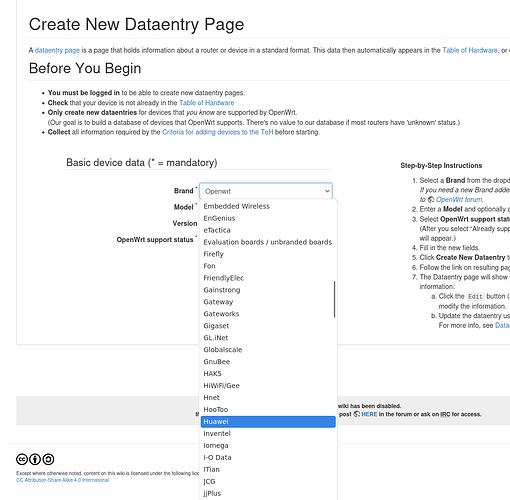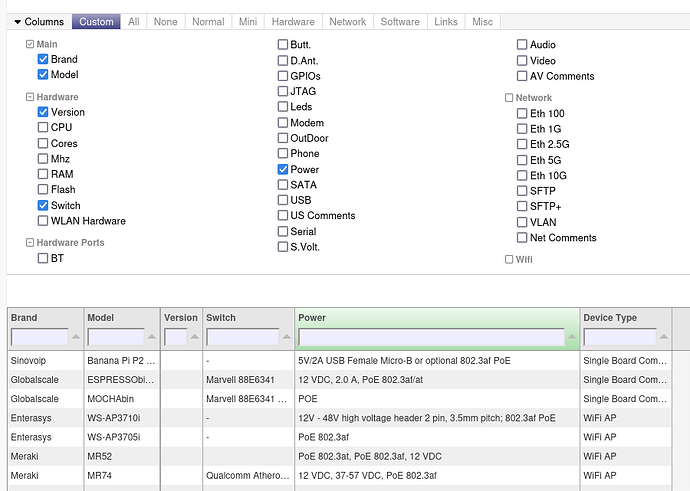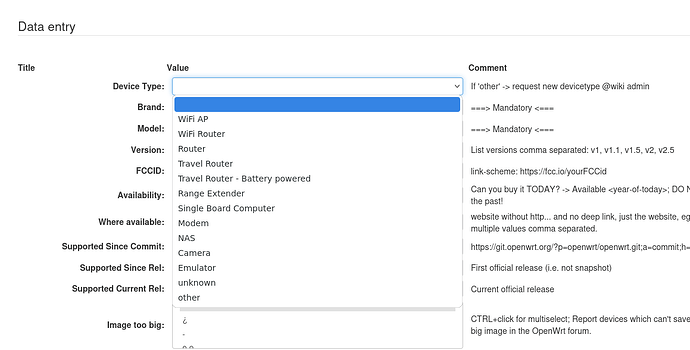Yes, there do seem to be a lot of variations in the Flash field. I worked with the fellow who set up the TechData pages, so I can give this background:
- The template for TechData pages allows/recommends that people control-click to multi-select from a list. See, for example, the TechData page for this old, discontinued (not very popular) router: https://openwrt.org/toh/hwdata/mqmaker/mqmaker_witi_board_256mb
- Click on the "Edit" tab at the lower left of the box listing the attributes to see the instructions.
- IIRC, this flexibility was added to cater to routers that have multiple flash/storage devices.
So the trick will be to intuit what the person who created the Techdata page was thinking, and how to represent the device in the best/proper light.
Earlier this year, I sucked up all the data from the ToH (I don't remember how). Here is the contents of the Flash column (below - sorted, removing duplicates). You can see the data at: https://docs.google.com/spreadsheets/d/1j_Yv62tdYzvA4iU216W3B0XHswXv2U2LrxQ0QOB5-vE/edit?usp=sharing
I am going to review several of these entries to see what the original author might have been thinking when they selected multiple Flash values...
PS One saving grace in all this is that I bet these multiple-entry devices are for older devices that are no longer useful/interesting. Consequently, it may not matter as much how they are displayed...
"" (empty string)
1, 128NAND
1, 512NAND
2
2, 128NAND
2, microSD
4
4, 8
4, 8, 16
4, 128NAND
4, 4096
4, 4096, eMMC
4, 8192, eMMC, microSD
4, microSDXC
8
8, 16
8, 16, microSD
8, 32
8, 128NAND
8, 512NAND
8, 4096, eMMC
8, 8192, eMMC
8, microSD
8, more, than, 8GB, eMMC
8, SD
16
16, 32
16, 32, 64
16, 32, microSD
16, 32NAND, SDHC
16, 128NAND
16, 128NAND, microSDXC
16, 256
16, 256NAND
16, 512NAND, microSD
16, 1024NAND
16, 4096, eMMC
16, 4096NAND
16, 8192, eMMC
16, 8192, eMMC, microSDXC
16, eMMC, microSD
16, microSD
16, microSDHC
16, microSDXC
16, SD
32
32, 128
32, 128NAND
32, 128NAND, 8192, eMMC, microSD
32, 128NAND, microSD
32, 256NAND
32, 2048, eMMC
32, microSD
32, microSD, microSDHC, microSDXC
32, SD, SDHC, SDXC
32NAND
64
64NAND
64NAND, 128NAND
64NAND, microSD
128
128, 2048NAND
128, 4096
128, 4096, 512NAND
128, 8192, eMMC
128, SD
128NAND
128NAND, 512NAND
128NAND, microSD
128NAND, SD
256
256, SD
256NAND
256NAND, 512NAND
256NAND, SD
512
512NAND
512NAND, microSD
512NAND, SD
1024
1024, eMMC
1024, SD, SDHC
1024NAND
1024NAND, SD, microSD
2048NAND, microSD
2048NAND, microSDHC
4096
4096, eMMC
4096, eMMC, microSDHC
4096, eMMC, more, than, 8GB, eMMC, microSDHC
4096, eMMC, SDHC
4096NAND
4096NAND, microSD
4096NAND, SD, microSD
4096NAND, SDHC
8192
8192, eMMC
8192, eMMC, microSD
8192, eMMC, microSDHC
8192, eMMC, microSDXC
8192, eMMC, SD
8192, microSDHC
8192NAND, microSD
CF, card
eMMC
eMMC, microSD
Flash MB
microSD
microSD, microSDHC
microSD, microSDHC, microSDXC
microSDHC
microSDXC
more, than, 8GB
more, than, 8GB, eMMC
more, than, 8GB, eMMC, microSD, microSDHC, microSDXC
more, than, 8GB, NAND
SD
SDHC
SDHC, microSDHC




